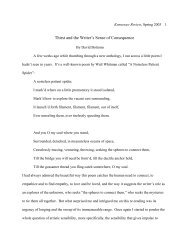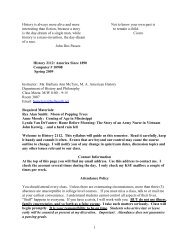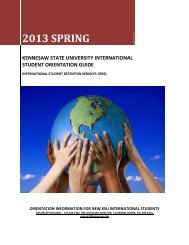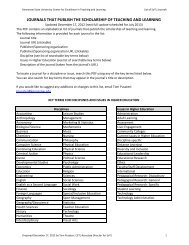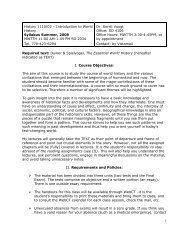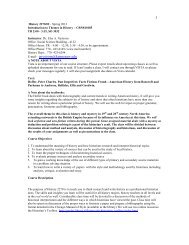Food, Gender and Cultural Hegemony - Kennesaw State University
Food, Gender and Cultural Hegemony - Kennesaw State University
Food, Gender and Cultural Hegemony - Kennesaw State University
You also want an ePaper? Increase the reach of your titles
YUMPU automatically turns print PDFs into web optimized ePapers that Google loves.
Cualli 135<br />
After the rabbit has been roasted, sauté finely minced onion in butter;<br />
once sautéed, season the onion with vinegar <strong>and</strong> sprinkle in cloves,<br />
saffron, pepper, <strong>and</strong> ginger. Cut the rabbit into pieces <strong>and</strong> put it in with<br />
the spice <strong>and</strong> onion mixture to simmer briefly. Lay some slices of<br />
bread on a plate <strong>and</strong> top with the rabbit pieces. (23)<br />
With their arrival in the New World the Spanish fervently wanted to reproduce<br />
civilization as they knew it: that is a Spanish society with Spanish cuisine. <strong>Food</strong> was<br />
symbolically very important <strong>and</strong> banquets were the most common form of expressing<br />
identity, religious unity, <strong>and</strong> a sense of victory or celebration. As compared to their<br />
successful efforts to introduce the Spanish language to the colonies, the effort to bring<br />
food culture to the New World faced several challenges. An important early challenge<br />
was the absence of particular plants that were considered essential for a people who<br />
were Christian <strong>and</strong> civilized. Most important among these were wheat <strong>and</strong> grapes,<br />
with olives also high on the list of foods necessary for a civilized life. In the early<br />
conquest period Spaniards had little choice but to eat indigenous foods, especially corn<br />
<strong>and</strong> cassava. In addition, food preparation was universally the province of indigenous<br />
women, even in those instances when Spanish women were present. This factor also<br />
increased the probability that early Spanish households would essentially be<br />
consuming indigenous-style meals, or at least meals with indigenous ingredients,<br />
cooked in ways common to the indigenous people.<br />
The primary foods of Nahua Mexico included maize or corn (the most<br />
important), beans (frijoles), squash, many kinds of chiles, cactus (nopal <strong>and</strong> maguey),<br />
sweet potatoes, cacao beans, Muscovy ducks, dogs, turkeys, <strong>and</strong> large quantities of<br />
fish, turtles, salam<strong>and</strong>ers, <strong>and</strong> algae (Cook <strong>and</strong> Borah 134-35). The early Mexican<br />
was very frugal <strong>and</strong> most of the time ate a meager, but nutritious diet that emphasized<br />
simplicity. No breakfast was consumed; atolli, a maize porridge sweetened with<br />
honey was eaten at 10 AM after some hours of work, with a main meal in the middle<br />
of the day. Maize-cakes, beans, pimento or tomato sauce <strong>and</strong> sometimes tamales were<br />
the common fare. Rarely did any meat accompany the meal. Water was the common<br />
[Type text]



